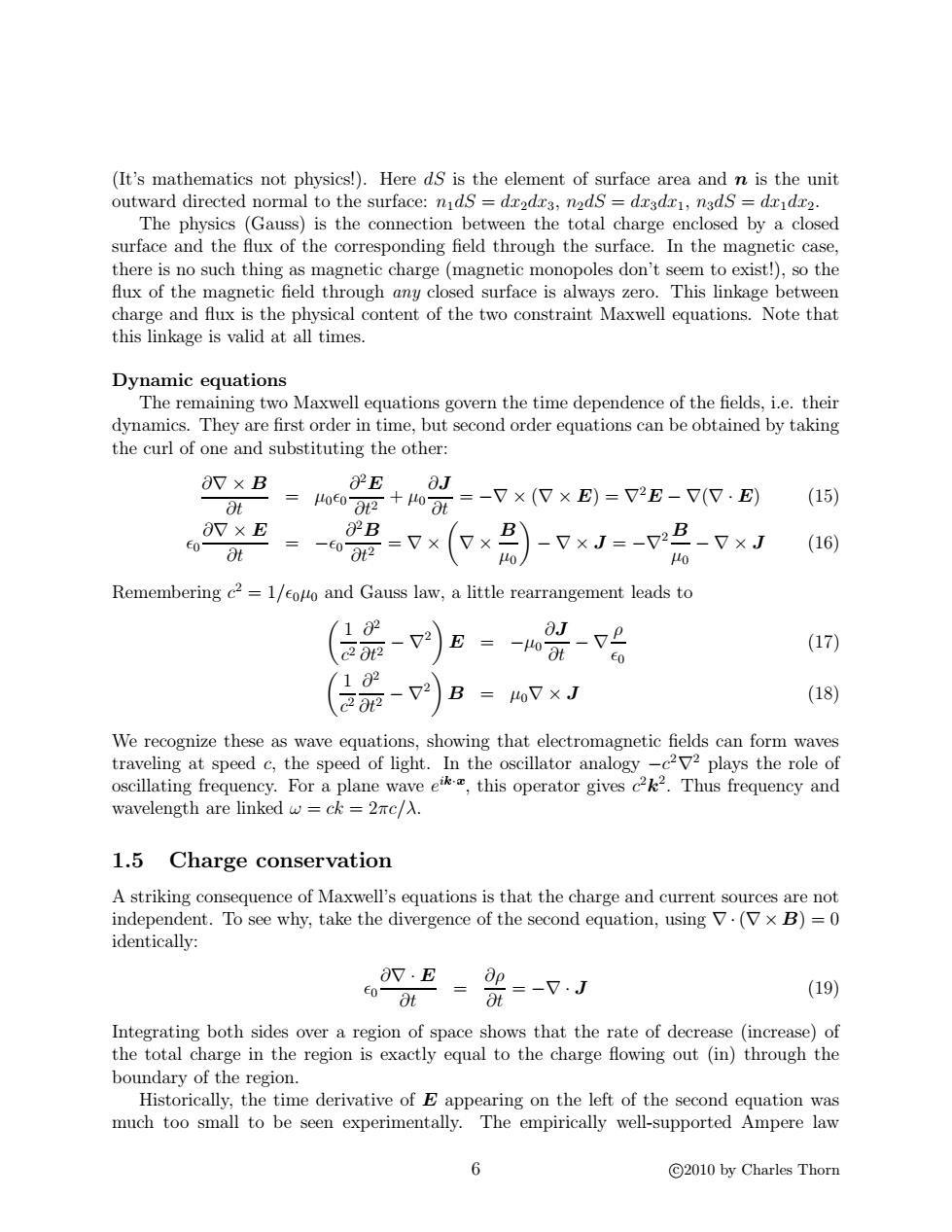正在加载图片...

(It's mathematics not physics!).Here dS is the element of surface area and n is the unit outward directed normal to the surface:nids=dz2dx3,nads dxsdr1,nads=dzid2. The physics (Gauss)is the connection between the total charge enclosed by a closed surface and the flux of the corresponding field through the surface.In the magnetic case, there is no such thing as magnetic charge (magnetic monopoles don't seem to exist!),so the flux of the magnetic field through any closed surface is always zero.This linkage between charge and flux is the physical content of the two constraint Maxwell equations.Note that this linkage is valid at all times. Dynamic equations The remaining two Maxwell equations govern the time dependence of the fields,i.e.their dynamics.They are first order in time,but second order equations can be obtained by taking the curl of one and substituting the other: OV×B 02E.0J =40+0元=-V×(V×E)=2E-V(V·E) (15) Ot ∂V×E B 三-02=VxG (×)-v×J=-号-v×J (16) Remembering c2=1/coto and Gauss law,a little rearrangement leads to /182 72 8J 2012- E=-Mt -2 (17)) E0 182 2那-2)B=oV×J (18) We recognize these as wave equations,showing that electromagnetic fields can form waves traveling at speed c,the speed of light.In the oscillator analogy -c2V2 plays the role of oscillating frequency.For a plane wave ek,this operator gives c22.Thus frequency and wavelength are linked w=ck =2c/A. 1.5 Charge conservation A striking consequence of Maxwell's equations is that the charge and current sources are not independent.To see why,take the divergence of the second equation,using V.(Vx B)=0 identically: ∂7.E 证✉-VJ (19) Integrating both sides over a region of space shows that the rate of decrease (increase)of the total charge in the region is exactly equal to the charge flowing out (in)through the boundary of the region. Historically,the time derivative of E appearing on the left of the second equation was much too small to be seen experimentally.The empirically well-supported Ampere law 6 ©2010 by Charles Thorn(It’s mathematics not physics!). Here dS is the element of surface area and n is the unit outward directed normal to the surface: n1dS = dx2dx3, n2dS = dx3dx1, n3dS = dx1dx2. The physics (Gauss) is the connection between the total charge enclosed by a closed surface and the flux of the corresponding field through the surface. In the magnetic case, there is no such thing as magnetic charge (magnetic monopoles don’t seem to exist!), so the flux of the magnetic field through any closed surface is always zero. This linkage between charge and flux is the physical content of the two constraint Maxwell equations. Note that this linkage is valid at all times. Dynamic equations The remaining two Maxwell equations govern the time dependence of the fields, i.e. their dynamics. They are first order in time, but second order equations can be obtained by taking the curl of one and substituting the other: ∂∇ × B ∂t = µ00 ∂ 2E ∂t 2 + µ0 ∂J ∂t = −∇ × (∇ × E) = ∇2E − ∇(∇ · E) (15) 0 ∂∇ × E ∂t = −0 ∂ 2B ∂t 2 = ∇ × ∇ × B µ0 − ∇ × J = −∇2 B µ0 − ∇ × J (16) Remembering c 2 = 1/0µ0 and Gauss law, a little rearrangement leads to 1 c 2 ∂ 2 ∂t 2 − ∇2 E = −µ0 ∂J ∂t − ∇ ρ 0 (17) 1 c 2 ∂ 2 ∂t 2 − ∇ 2 B = µ0∇ × J (18) We recognize these as wave equations, showing that electromagnetic fields can form waves traveling at speed c, the speed of light. In the oscillator analogy −c 2∇2 plays the role of oscillating frequency. For a plane wave e i·✁ , this operator gives c 2k 2 . Thus frequency and wavelength are linked ω = ck = 2πc/λ. 1.5 Charge conservation A striking consequence of Maxwell’s equations is that the charge and current sources are not independent. To see why, take the divergence of the second equation, using ∇ ·(∇ × B) = 0 identically: 0 ∂∇ · E ∂t = ∂ρ ∂t = −∇ · J (19) Integrating both sides over a region of space shows that the rate of decrease (increase) of the total charge in the region is exactly equal to the charge flowing out (in) through the boundary of the region. Historically, the time derivative of E appearing on the left of the second equation was much too small to be seen experimentally. The empirically well-supported Ampere law 6 c 2010 by Charles Thorn